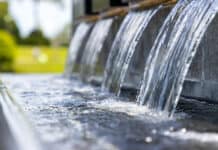Many states and municipalities have strict guidelines for how and when landscape turf and shrubbery can be watered. In most cases, there are stiff fines for overwatering or watering on non-designated days. Plus, the cost for wasted water can add significantly to operations budgets. Rain Bird, an Azusa, CA-based manufacturer and provider of irrigation products and services for the intelligent use of water, offers these five steps for facility managers to follow in their landscape care practices to reduce water usage.

1) Know Your Property
Understand Your Soil. The soil type on your property is an important factor in determining how fast and how often you can water. Different types of soils have different intake rates, which will influence the precipitation rate and type of sprinkler you choose. The ability of soil to hold moisture and the amount of moisture it can hold will greatly affect your irrigation schedule.
Know Your Water Pressure. Water pressure varies greatly based on where your property is located. High water pressure or fluctuating water pressure can have a significant impact on the efficiency of your irrigation system. If you do have high pressure, make sure you install products equipped with pressure regulating devices, which can save you up to one gallon per minute per device.
Divide Your Property Into Zones By Plant Types. Different plants need different amounts of water. Divide your property into separate zones so groundcover, shrubs and trees can be watered separately and less frequently.
Choose Your Plants Wisely. When designing your landscape, use drought-tolerant plants when possible. It is entirely possible to have a beautiful, sustainable landscape using drought-tolerant plants. Reserve your use of grass for areas with high value, visual prominence or frequent physical use.
Protect Your Trees. Tree roots need air and water to survive transplant shock and to thrive long term. Consider using proven deep root watering devices to protect your investment and accelerate healthy tree growth.
Use Mulch To Improve Water Retention. A great way to conserve water and help plants stay healthy is to spread mulch in shrub beds, tree rings and flower gardens. Applying mulch helps drainage, encourages root development and improves soil by making nutrients more available to plants. It also insulates soil and plants in winter months, while cooling the soil and reducing water use during hot summer months.
Use Drip When Possible. Drip irrigation delivers the water directly to the base of plants, saving up to 80 percent over watering with traditional overhead irrigation.
2) Make Sure You Have A Water Efficient System
Incorporate A Weather Based Smart Controller. A weather adjusting (or “smart”) controller automatically adjusts your watering schedule to take into account both the seasons and current weather conditions. This allows the controller to optimally water plants year round without the need to constantly reprogram the controller.
Continuously Monitor The System. By using a central control system that continuously monitors your system, you’ll receive real-time alerts if there’s ever a problem. This allows you to address issues like broken heads or damaged lines right away, without hours of wasted water leakage.
Protect Against Leaks. Flow sensing will help you limit the liability and costs associated with broken pipes, stuck valves, water loss and unauthorized water use. Add a master valve and flow sensing to your system for peace-of-mind.

3) Select The Right Products
Eliminate Erosion And Runoff. Water can puddle or pool around heads installed at the bottom of slopes or hills, causing soggy areas. Use spray heads and rotors with pre-installed check valves and drip line with check valve emitters to prevent drainage issues.
Use Drip For Shrubs And Flower Beds. Drip products are ideal for watering shrubs and plants. Point-source drip watering allows soils to absorb water more completely into the root zones of plants. Use low-volume drip watering to achieve greater efficiency for healthier plants and to conserve water and eliminate excessive runoff.
Water Only Things That Grow. Drip irrigation prevents weeds and encourages healthier plants by watering each plant’s root zone, eliminating overspray and evaporation. This also keeps water off foliage, so fungi cannot form.
Select Products That Deliver Water Evenly Across The Entire Landscape.
Different types of emitters apply water at different rates. To make sure you are applying water evenly and not overwatering some portions of your landscape, use sprays and rotors that have matched precipitation rates and are designed to be used together in the same zone.
Control Pressure And Reduce Flow. Running your system with too much pressure creates misting and excess flow, which can waste up to a gallon per minute per spray or rotor. Adding pressure regulation to your sprays and rotors is just like adding a low flow showerhead. It allows the nozzles to perform as designed, delivering the right amount of water.
4) Water At The Right Times
Irrigate In The Morning. If your municipality does not have water time restrictions, irrigate between 5 a.m. and 10 a.m.—when the sun is low, winds are calm and temperatures are cool. Midday irrigating tends to be less efficient due to evaporation and wind drift. Irrigating in the evening isn’t a good idea either because leaves can remain wet overnight—an open invitation for fungus to grow. By irrigating in the morning, you give the leaves a chance to dry out.
Follow Local Rules. Check with your local water provider to see what days and times you are allowed to water your property. Then, adjust your controller to avoid costly fines.
Don’t Irrigate Within 48 Hours Of Rain. New regulations in some locales require that you do not run any irrigation within 48 hours of a rain event. Use a ‘smart’ weather-based central control option or rain sensor technology to prevent or delay irrigation during and after it rains.
5) Water Only When Your Landscape Needs It
Break Up Watering Times Into Shorter Segments. Applying more water than the ground can absorb leads to excess water running off onto streets or sidewalks. The Cycle+Soak feature on Rain Bird controllers splits watering times into a few shorter periods, so water has a chance to soak in.
Adjust Watering Times For Sunny And Shady Areas. Controllers are available with multiple programs allowing you to group irrigation stations together based on sun and shade.
Water Only When Your Site Demands It. Watering only when your plants need it is the best way to save water and to assure healthy landscapes. Rain Bird offers multiple ways to accomplish this, from the SMRT-Y Soil Moisture Sensor to the IQTM Central Control.
Protect Against Unauthorized Irrigation. Take control and make sure you are only irrigating your property when it needs it. Rain Bird’s IQ Central Controller has pin-code protection to prevent unauthorized irrigation.
Tap Into Alternative Water Sources. Consult your local water provider to see if recycled water is available for use in your area. And, when you make the switch, make sure you are using products designed to stand up to the harsh chemicals found in recycled water.
Learn more at TurfMagazine.com. Turf keeps landscape and design/build professionals up-to-date on emerging trends, best practices, operational efficiencies, marketing/sales & human development.



















![[VIDEO] Collect Asset Data at the Speed of Walking a Building](https://facilityexecutive.com/wp-content/uploads/2024/02/maxresdefault-324x160.jpg)